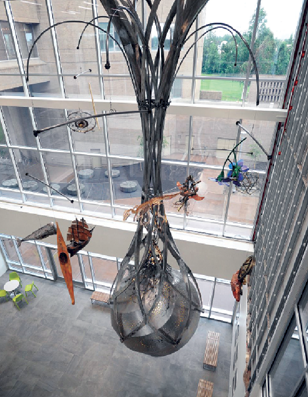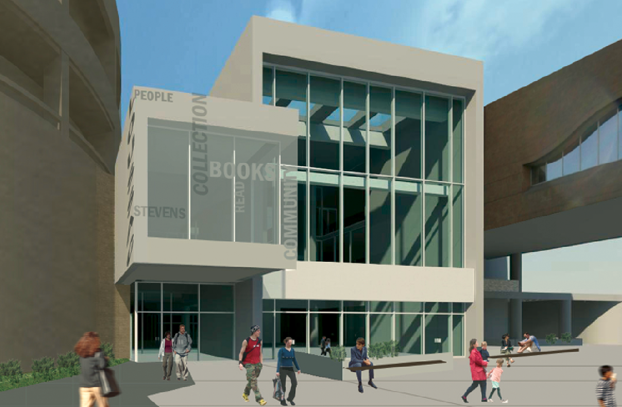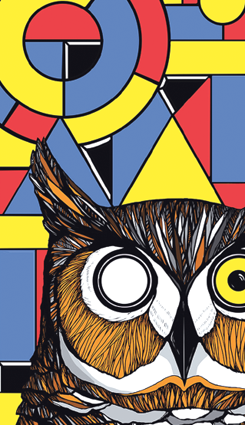|
In one of his most famous short stories, the Argentine writer Jorge Luis Borges compares the library to a universe of galleries in which a visitor finds unlimited possibilities. Every feature of a library is an open door to worlds of fantasy, knowledge, history, or intelligence. The idea of a library as a passage between worlds guided the renovation of the Loussac Library in Midtown.
Mexican-American architect Mónica Sullivan, lead designer for the project, explains that rather than being a doorway the library was intended as a portal, an open door. But “portal is a stronger statement than door,” she says, because it is monumental. With its large windows, the new Loussac Library is a welcoming portal connecting life inside the building to what happens outside. When the project launched in 2011, the team that would give Loussac a new face surveyed the community about what should be improved. Many users agreed that it was difficult to enter the library. Also, Sullivan says, “the elevated entrance had oxidation problems and prevented light from entering the library.” So among her first objectives was removing the old plaza as well as the street that ran under it, which was a hazard for children. Her team also created a new entrance fronted by a square for community activities. Thanks to its glassed-in entry, the Loussac Library is now a portal of light. The library is also a portal to knowledge, which in the twenty-first century is found not only in books. But the builders of the 1980s library could not have imagined today’s digital revolution. To adapt the space to the contemporary world, Mónica and her team at RIM Architects opened areas for the use of computers creating “a better balance between books and technology.” The Loussac Library has traditionally been a meeting place for the community, a portal to connection with other Anchorage residents. To reinforce this idea, the renovation has led to new community spaces, conference halls, meeting rooms, and the large atrium with a cafeteria on the first floor. To give the staff more time to interact with the community, the book return system has been streamlined and automated. The new system sorts items by categories and conveys them upstairs for easier shelving. Aware that the library is also a space for reflection, Mónica and her team expanded the spaces for solitary reading. In this way the library is a portal to encounters with oneself. The Portal of Perception is the name of one of the three works of public art that were incorporated into the library through the 1% for Art program. Created by Richard Cawley Studios, this suspended sculpture can be seen from three of the four floors of the library. The Portal of Perception reproduces in metal the anatomic representation of an eye. The front of the eye can be seen from the atrium floor. Its pupil contains mirrors that reproduce to infinity the image of the viewer below. Enzina Marrari, curator of the 1% for Art program, says that a set of lights around the pupil change constantly according to an algorithm, so the image in the mirror is never the same. The Portal of Perception speaks to what we capture through our senses and how it is transformed into knowledge. “The eye is the portal. The nerves that hold it are the neural network, and the suspended objects are what we have perceived and is transformed into knowledge,” explains Marrari. Each object tells a story. For example, among the hanging pieces is a kayak made by Andrew Abyo, a native Alaskan artist. There are also images of Buddha, Moby Dick, a sextant, an forget-me-not (Alaska’s state flower), and the miniature replica of the dinosaur skeleton found near Fairbanks. Richard Cawley Studios’ piece envisions the library as a portal to imagination, knowledge and wisdom. Through Inupiaq Holly Mitiquq Nordlum’s art piece in the book drop, the library also becomes a portal connecting us to ancient times. The young artist’s work depicts a traditional tale, how the Caribou gained the sense of smell. Marrari explains that Nordlum “wanted to honor the land of Anchorage, honor the history and culture of the land in which the library sits on, which is Dena’ina land. Dena’ina people have been around for a thousand years.” The third public art work to be placed in the library is intended for the children’s section. Created by illustrator Owen Tucker, the piece will include murals on the entrance and exit doors of this area, and colorful decoration on its windows. The central character is an owl who greets the children at the front door and tells them good bye at the exit having transformed into a robot. With this piece, the library also becomes a portal to fantasy and a world of wonders. Like the Borges story referred to at the beginning, the new Loussac Library is a portal that transports us to possible worlds, including the hearts of our cultures. It is a doorway open to diversity, containing books in the languages of many Anchorage residents. The largest collections are in Russian and Spanish. |


